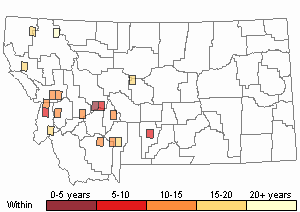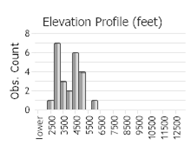View in other NatureServe Network Field Guides
NatureServe
Montana
Utah
Wyoming
Idaho
Wisconsin
British Columbia
South Carolina
Yukon
California
New York
Gray Fieldslug - Deroceras reticulatum
Other Names:
Limax reticulatus, Limax agrestis, Limax tunicata, Agriolimax reticulatus, Agriolimax agrestis
General Description
A medium-sized slug, individuals reaching to about 50 mm extended. Base color is cream or flesh-colored on the head, mantle and tail, sometimes with darker flecking on the mantle and tail. The mantle is oval, about 1/3 to 2/5 of the body length, has a series of concentric ridges somewhat like a fingerprint, and lacks a notch along the posterior margin. The tail is covered with a series of small furrows and elongated tubercles, and is slightly keeled near the posterior end. The pneumostome is posterior to the mantle cleft and on the right side. The sole is pale and tripartite (having two longitudinal furrows); the mucous is clear when crawling but milky when animal is disturbed (McDonnell et al. 2009, Hendricks 2012, Burke 2013). Internal anatomy is described by Pilsbry (1948) and Forsyth (2004).
Diagnostic Characteristics
A combination of small to medium size, lack of visceral mantle hump, concentric fingerprint-like ridges on the mantle, lack of notch in right posterior mantle margin, tripartite sole and unkeeled tail, and grayish cream-color with dark gray patches separate this species from all others. Lighter and mottled color, larger size, and production of milky mucous when disturbed separate this species from the darker and smaller D. laeve.
Species Range
Montana Range
Range Descriptions

 Non-native
Non-native
Range Comments
Native to southwestern Europe; introduced throughout Europe, Asia, Africa, Australia, and the Americas. In Montana, recorded in seven counties across the state, but likely occurs in many more, especially in yards and gardens. Elevation range is 962 to 1945 m (3155 to 6380 ft). As many as 15 individuals were found at one site in Chouteau County in late September, but many more likely occur at times in some residential and agricultural areas Hendricks 2012).
Observations in Montana Natural Heritage Program Database
Number of Observations: 28
(Click on the following maps and charts to see full sized version)
Map Help and Descriptions
Relative Density

Recency



 (Observations spanning multiple months or years are excluded from time charts)
(Observations spanning multiple months or years are excluded from time charts)
Habitat
Found in a variety of modified habitats near moisture (lawns, gardens, irrigated fields, and roadsides), sometimes in sites without a tree canopy. Canopy tree species include black cottonwood, ponderosa pine and aspen, with a secondary canopy including alder and willow. Most often found under woody debris, leaf litter and rocks as well as in lawns under planters and ornaments (Hendricks 2012).
Management
Considered a serious agricultural and horticultural pest.
For information and resources on plant pests and diseases see the USDA's Animal and Plant Health Inspection Service's
Plant Pests and Diseases ProfilesUseful Links:Central and Eastern Montana Invasive Species TeamMontana Invasive Species websiteAquatic Invasive SpeciesStewardship Responsibility
References
- Literature Cited AboveLegend:
 View Online Publication
View Online Publication Burke, T. E. 2013. Land snails and slugs of the Pacific Northwest. Corvallis, OR: Oregon State University Press. 344 p.
Burke, T. E. 2013. Land snails and slugs of the Pacific Northwest. Corvallis, OR: Oregon State University Press. 344 p. Forsyth, R.G. 2004. Land snails of British Columbia. Royal British Columbia Museum: Victoria, British Columbia, Canada. 188 pp.
Forsyth, R.G. 2004. Land snails of British Columbia. Royal British Columbia Museum: Victoria, British Columbia, Canada. 188 pp. Hendricks, P. 2012. A Guide to the Land Snails and Slugs of Montana. A report to the U.S. Forest Service - Region 1. Montana Natural Heritage Program, Helena, MT. vii + 187 pp. plus appendices.
Hendricks, P. 2012. A Guide to the Land Snails and Slugs of Montana. A report to the U.S. Forest Service - Region 1. Montana Natural Heritage Program, Helena, MT. vii + 187 pp. plus appendices. McDonnell, R. J., T. D. Paine, and M. J. Gormally. 2009. Slugs, a guide to the invasive and native fauna of California. University of California Division of Agriculture and Natural Resources Publication 8336. 21 p.
McDonnell, R. J., T. D. Paine, and M. J. Gormally. 2009. Slugs, a guide to the invasive and native fauna of California. University of California Division of Agriculture and Natural Resources Publication 8336. 21 p. Pilsbry, H.A. 1948. Land Mollusca of North America (north of Mexico), Volume II Part 2. The Academy of Natural Sciences of Philadelphia Monograph Number 2(2): 521-1113.
Pilsbry, H.A. 1948. Land Mollusca of North America (north of Mexico), Volume II Part 2. The Academy of Natural Sciences of Philadelphia Monograph Number 2(2): 521-1113.
- Additional ReferencesLegend:
 View Online Publication
View Online Publication
Do you know of a citation we're missing? Frest, T.J. and E.J. Johannes. 2001. An annotated checklist of Idaho land and freshwater mollusks. Journal of the Idaho Academy of Science 36(2):1-51.
Frest, T.J. and E.J. Johannes. 2001. An annotated checklist of Idaho land and freshwater mollusks. Journal of the Idaho Academy of Science 36(2):1-51. Grimm, F.W., R.G. Forsyth, F.W. Schueler, and A. Karstad. 2009. Identifying land snails and slugs in Canada: introduced species and native genera. Canadian Food Inspection Agency, Ottawa, ON. 168 pp.
Grimm, F.W., R.G. Forsyth, F.W. Schueler, and A. Karstad. 2009. Identifying land snails and slugs in Canada: introduced species and native genera. Canadian Food Inspection Agency, Ottawa, ON. 168 pp. Hendricks, P. 2005. Surveys for animal species of concern in northwestern Montana. Unpublished report to the Montana Department of Fish, Wildlife & Parks, Montana Natural Heritage Program, Helena, Montana, May 2005. 53 p.
Hendricks, P. 2005. Surveys for animal species of concern in northwestern Montana. Unpublished report to the Montana Department of Fish, Wildlife & Parks, Montana Natural Heritage Program, Helena, Montana, May 2005. 53 p.
- Web Search Engines for Articles on "Gray Fieldslug"
- Additional Sources of Information Related to "Snails / Slugs"





